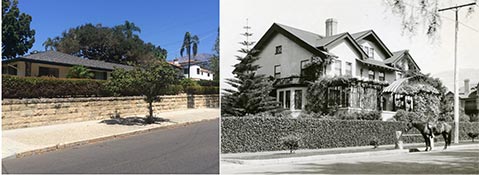Fabled Gables: 229 East Pedregosa Street

Original Owner: Edward Payson Ripley and Frances Harding Ripley
Year Built: 1904
Architect: Francis W. Wilson
Edward Payson Ripley was born on October 30, 1845, in Dorchester, Massachusetts. His family’s descendants had settled in the New World colonies in 1638, where their lineage included nine prominent blacksmiths.
E.P. Ripley attended public schools and began his professional career in 1862 alongside his father as a dry goods merchant. Yet six years later, he jilted his father’s enterprise to become an officer in the booming U.S. Railway Service, where he rose through the ranks and became president of the Santa Fe railroad by 1895. In 1871, Edward married Frances E. Harding, also of Dorchester, Massachusetts, where they had four children.
Ripley first visited Santa Barbara in March 1894. Two years later, the entire family accompanied him, and they stayed at the famed Baxter Terrace, a residential hotel for wintering guests. (Ironically, this historic Victorian, located at 302 West Micheltorena Street, currently operates an upscale studio apartment house). In March 1900, they once again returned to Santa Barbara by private railcar with several Chicago friends in tow. Among the invited were Daniel E. Richardson and his wife, who purchased acreage along upper Cold Springs Road in Montecito where they built a craftsman-style cottage. In subsequent years, this bungalow became the caretaker’s residence when their verdant acreage was acquired by Henry Bothin, a prominent California businessman with ties to water rights in the San Francisco Bay Area. It was here that he built a 12,000-square-foot, Italianate-style villa, which he christened “Piranhurst.” The renowned estate, with elaborate Tea Gardens, is still nearly intact and located across the street from Westmont College.
Initially, the wintering group contemplated a three-week jaunt; however, due to the balmy, Mediterranean-style weather for which Santa Barbara is well known, their vacation was extended by several weeks. They stayed in nearby Montecito in a guest cottage on the grounds of the Santa Barbara Country Club (the present site of the Four Seasons Biltmore Hotel), where they golfed on one of the first courses in California.
The following year, during their winter excursion, the families rented one of the Crocker Row properties, located on the 2000 block of Garden Street. In subsequent years, the family returned for the winter season, where they leased vacation homes on Pedregosa Street and later on Anacapa Street.
In April 1904, the Ripleys bought acreage on the corner of Pedregosa and Garden streets. It was here they commissioned renowned California architect Francis W. Wilson to design a handsome three-story, 20-room home on the rustic land. By early 1905, the family domain was completed at a cost of $15,000.
E.P. Ripley was a member of the Santa Barbara Chamber of Commerce and, in 1918, was voted in as a director. Shortly thereafter, he was elected president of the Museum of Natural History on Mission Canyon, only to serve for about one year, as he died in February 1920.
With success and fortune on his side, he was known by friends and colleagues to “meet everyone with common footing.” His additional accomplishments include townships named in his honor (Ripley, California and Ripley, Oklahoma) for having established railroad service to these rural locals.
One of the Ripley’s four children, Alice Harding Ripley, was married to Schuyler Montgomery Coe in the bucolic gardens on the property and maintained the family home as a part-time residence. The house, badly damaged by the 1925 earthquake, was restored to its original status by Alice. The countrified landscape was lovingly maintained by F.J. Tone, the family’s groundskeeper, for more than four decades, and was regularly visited on the Garden Tours for many eventful seasons. Shortly after Alice’s death in 1957, the residence was torn down and subdivided to make way for several property lots. Sadly, all that remains today is the Italian stonewall that surrounds the perimeter of the original property line.



